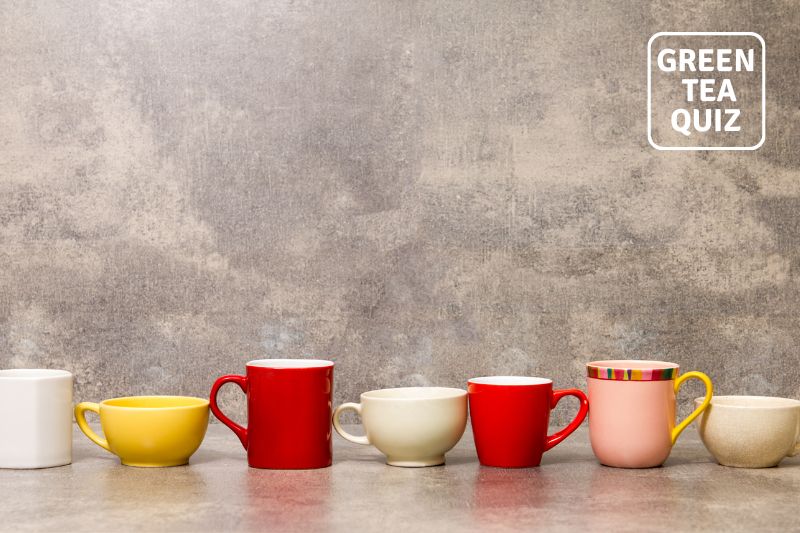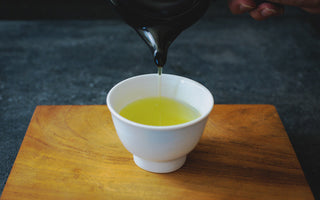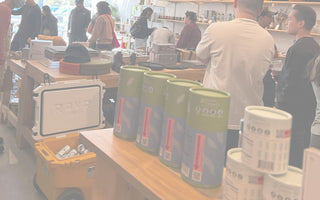What the Covering Process Does to Tea
We all know that to produce a delicate, umami-flavored matcha green tea, the covering process is a vital step. The effects of the shade is what distinguishes matcha from sencha, or regular green tea. However, matcha isn’t the only tea that is covered before the harvesting season.
Gyokuro, also known as “jade dew,” is another type of Japanese green tea that undergoes the shading phase. Everything about matcha and gyokuro is the same, up until the actual processing of the harvested tea leaves. For matcha, a very intricate and careful practice of destemming the leaves, extracting the veins is performed. This leaves only the juicy, vital part of the leaf to be dried out into tencha. Not a single drop of water remains to ground tencha into the fine, airy vibrant powder that is matcha.
The production of gyokuro tea goes down another path. After the shading phase, the plants are steamed first, then dried into rolled-up crinkled versions of the original leaves. Gyokuro tea leaves become a lovely dark green reminiscent of seaweed, with a rich, sweet flavor. When brewed, the tea has an amber, dewy appearance.
Both of these classic Japanese teas, while made differently, incorporate the covering process. What exactly is this famous, traditional Japanese tea-farming practice, where did It originate from, and why is it necessary to create such delicate, refined green teas?
Kabusecha is covered for 7-10 days, Gyokuro is covered at least 20 days.

By purposely blocking sunlight for a few days before new sprout grow, the tea creates a very unique aroma and taste.

Due to the special net blocking sunlight, the tea leaves increase chlorophyll, making the color of the tea a darker green. Tea made from such leaves create a beautiful emerald green color which is rare to see in other types of green tea.
History of The Covering Process
Before matcha, green tea in 12th century Japan was popular for its health benefits, and less for its flavor. Seen as a medicine, green tea was consumed despite the earthy, bitter taste. Tea leaves were powdered using a stone mill and even a whisk was used to blend it with hot water, like matcha today.
It wasn’t until the 15h or 16th century that people began covering green tea leaves – and for quite an interesting reason. Fearing that the cold of the winter months would destroy the growing tea leaves, farmers began covering crops with a canopy, unaware of the effect this would have. They would usually cover the crops right before they began to sprout, which was usually in the late spring. Realizing the immense difference in the flavor of the tea – from bitter to sweet umami– that covering green tea leaves became common practice. So, yes, this method which is incredibly important in the discovery of matcha was discovered by accident.
Today, not every green tea is produced using the covering method. Kabuse sencha refers to the few, high-quality teas that are shaded. Sencha literally means tea leaves that are steeped in hot water. Kabuse is based off the Japanese verb “kabusu,” which means “to cover.”
Matcha and gyokuro are two such exclusive example of Kabuse-sencha. Gyokuro is quite expensive as it requires a longer time under shade each springtime. Shading can be damaging if there isn’t a good balance. Being without the sun for too long is taxing on tea plants. All of the sugar than been stored from photosynthesis from the previous year is used up during the shading time, so Gyokuro is harvested once annually.
The Science Behind the Covering Process

To find out how shading green tea, or Camellia sinensis, result in such dramatic changes in flavor, appearance, and nutrients, let’s look at the science.
All plants need water, rich soil, and most importantly, sunlight. Such things are essential for plants to thrive. Green tea plants are no exception. So why would limiting sunlight produce better quality tea leaves?
The reason for this is stress. Just like a healthy amount of stress can sometimes help humans perform better, the same can happen with plants. Adding a certain stressor to a plant’s environment can affect its growth in a surprisingly positive way. Stressors can be anything from insects eating the plant to being in a high elevation.
For Japanese green tea, shading is the stressor. Without the sun, photosynthesis, the process of creating energy from sunlight, cannot occur. Cutting off the sunlight forces the plant to work harder to produce the chlorophyll it needs to survive. This chemical change is essential in creating the great effects of shading. The overabundance of chlorophyll gives sencha its bright, lush green color. The increased chlorophyll production not only exudes a beautiful verdant color, but it also results in softer, more delicate leaves.
Effects of Covering on Nutrients and Health Benefits
 In addition to chlorophyll, other chemical productions take place due to shading. While plants love the sun, the light usually breaks down some important nutrients in the leaves. Amino acids would be deconstructed and transformed into chatecins due to the sun, which causes the bitterness of normal green tea. So when blocked from the sunlight, amino acids are preserved, leaving sweet notes of flavor.
In addition to chlorophyll, other chemical productions take place due to shading. While plants love the sun, the light usually breaks down some important nutrients in the leaves. Amino acids would be deconstructed and transformed into chatecins due to the sun, which causes the bitterness of normal green tea. So when blocked from the sunlight, amino acids are preserved, leaving sweet notes of flavor.
One such amino acid is L-theanine, which is important for improved concentration, calmness, and relaxation. The L-theanine in green tea is known for promoting alpha brain waves, which reduce stress and boost one’s mood. L-theanine works with caffeine to gradually release a sustainable amount of caffeine, for long-lasting energy.
Catechins are a type of antioxidant, the most famous one being EGCG (epigallocatechin gallate). Matcha and Gyokuro have the highest amounts of EGCG of all green teas. Because it is an antioxidant, it is critical in fighting toxic free-radicals which can prevent cancer down the line. Other health benefits include reducing blood pressure, maintaining weight, and improving skin. EGCG is instrumental in protecting skin from toxins, stress, anti-aging, and sun damage.
Shading the tea can also magnify the caffeine content. The high chlorophyll affects the amount of caffeine in the tea leaf. That’s why matcha green tea and gyokuro green tea have the most caffeine compared to other types. Gyokuro has concentrated caffeine, with an average of 35 mg per 8 ounces, due to its extended time spent in the shade. The only reason why matcha is known for having more is that the entire leaf is grounded into powder.
Different Types of Covering
Depending on the type of tea, there are a few different types of coverings. Some of the types of teas that use the covering method include matcha, gyokuro, and kabuse-cha. The differences in these teas are in the length of time they are covered.
Gyokuro tea requires about 20 days of being covered to achieve a high grade. With the longest amount of time shaded compared to other teas, the high production of chlorophyll sinks in to create Gyokuro's deep, forest green color. Gyokuro tea leaves are hand-picked between May and June.
Kabuse-cha, or “covered green tea” is a cross between sencha and gyokuro. Kabuse-cha is faster to harvest than gyokuro, needing about half as much time. Usually, the time spans from 10-14 days for Kabuse-cha. The short time limit results in a tea that is a mix of sencha mellowness and a bit of umami.
There are a couple types of covering methods: direct and canopy covering. With direct covering, plastic or burlap material cloaks the leaves directly. The covering can be black in color, but other colors are used for specific purposes.
Canopy covering is when material is added gradually, almost like the plants are being weaned off of sunlight. In the past, farmers shaded tea plants with straw, bamboo, or grass, which falls under the category of canopy because the shading structures take time to be built.

The Advantages and Disadvantages of Covering Process
Shading tea plants is not as simple as placing a sheet over them. There is a reason why this covering process increases the cost of high-quality tea like matcha and gyokuro. The aim of producing perfect tea is a fragile balance between the amount of yield produced and quality. Farmers must be precise in the process of shading tea plants to harvest leaves in great condition.
Challenges
The process of covering tea plants is in o itself, a difficult one. Farmers have one chance to do it properly and keep the plants covered for the exact time needed to produce a specific time of tea. Everything from taste to appearance to nutritional content depends on the covering process.
Before covering, a bare-bones framework is constructed around the crops. This structure take time and energy to build in preparation for covering. Once the material shields leaves from the sun, keeping it on is another challenge. Wind can cause plastic covering to move around, either harming the leaves or leaving them exposed to the sunlight.
Benefits

The most prominent advantage of shading tea leaves is the resulting quality. Shading leaves create a delicacy, regardless of which type of tea, whether it's matcha, kabuse-cha, or gyokuro. The wonderful umami taste, lack of bitterness, aromatic earthy scent, and chlorophyll induced green color makes the process worth it. Furthermore, shaded teas win over other teas in antioxidant, caffeine, and nutritional content.
Buy Gyokuro Shaded Imperial Japanese Premium Green Tea
Get Free Bonus Books

Sign up for free to the Green Tea Club to get advice and exclusive articles about how to choose Japanese Tea, and tips, tricks, and recipes for enjoying Japanese tea.
About the author
Kei Nishida
Author, CEO Dream of Japan
Certification: PMP, BS in Computer Science
Education: Western Washington University
Kei Nishida is a passionate Japanese green tea connoisseur, writer, and the founder and CEO of Japanese Green Tea Co., a Dream of Japan Company.
Driven by a deep desire to share the rich flavors of his homeland, he established the only company that sources premium tea grown in nutrient-rich sugarcane soil—earning multiple Global Tea Champion awards.
Expanding his mission of introducing Japan’s finest to the world, Kei pioneered the launch of the first-ever Sumiyaki charcoal-roasted coffee through Japanese Coffee Co. He also brought the artistry of traditional Japanese craftsmanship to the global market by making katana-style handmade knives—crafted by a renowned katana maker—available outside Japan for the first time through Japanese Knife Co.
Kei’s journey continues as he uncovers and shares Japan’s hidden treasures with the world.
Learn more about Kei







